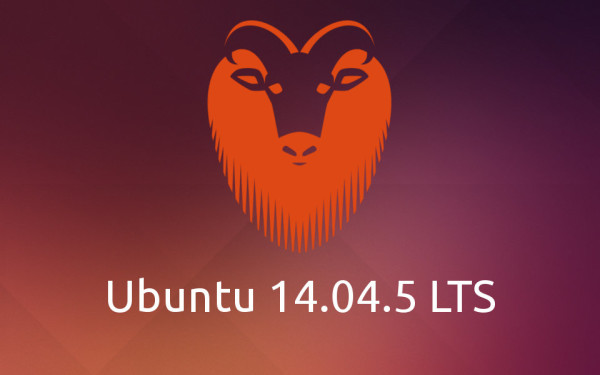The Ubuntu Team has announced the release of Ubuntu 14.04.5 LTS. It’s the fifth and final point release that includes new hardware enablement stack (HWE) from Ubuntu 16.04 LTS.
The Ubuntu team is pleased to announce the release of Ubuntu 14.04.5 LTS (Long-Term Support) for its Desktop, Server, Cloud, and Core products, as well as other flavours of Ubuntu with long-term support.
We have expanded our hardware enablement offering since 12.04, and with 14.04.5, this point release contains an updated kernel and X stack for new installations to support new hardware across all our supported architectures, not just x86.
As usual, this point release includes many updates, and updated installation media has been provided so that fewer updates will need to be downloaded after installation. These include security updates and corrections for other high-impact bugs, with a focus on maintaining stability and compatibility with Ubuntu 14.04 LTS.
Upgrade to Ubuntu 14.04.5:
Ubuntu 14.04 users can easily upgrade to the 14.04.5 point release by running a regular system update via Software Updater.
Or run the commands in terminal:
sudo apt-get update && sudo apt-get upgrade
Note that the updated hardware enablement stack, Kernel 4.4 and X graphics stack from 16.04, will be available through the update only for those who installed Ubuntu 14.04 using the 14.04.2 or newer disc image.
Those who installed Ubuntu 14.04 from the original or 14.04.1 disc image will keep the original Trusty stack. Anyone wishing to opt into the new Kernel and X graphics stack may do so by running the command below in terminal:
sudo apt-get install --install-recommends linux-generic-lts-xenial xserver-xorg-core-lts-xenial xserver-xorg-lts-xenial xserver-xorg-video-all-lts-xenial xserver-xorg-input-all-lts-xenial libwayland-egl1-mesa-lts-xenial
For Sever edition, run this command instead:
sudo apt-get install --install-recommends linux-generic-lts-xenial













Hi Ji.. thanks for sharing.. but hope you can help me with my ubuntu..
My laptop was running ubuntu 14.04 and using radeon HD graphich card and there is notification below:
New important security and hardware support update
WARNING: Security update for your current Hardware Enablement Stack ended on 2016-08-04 *http://wiki.ubuntu.com/1404_HWE_EOL
Then i click install until it finished. After it i reboot my laptop and got blackscreen and doesn’t want go till login screen then i push shutdown button and turn on it again and try go to recovery mode and choose to previous kernel then reboot. After it i’m facing the same problem.. my laptop got blackscreen.
And now i just already installed a fresh copy of ubuntu 14.04… and i don’t want to update anymore until i knew how to resolve that problem..
Thank you :)
Hello Ji, same problem here. It looks like Ubuntu is adopting the MS (win…s) philosophy of upgrade without compatibility. After, since my point of view, been one of the best desktop suites based in Linux Operating System.
The update deletes all the propitiatory AMD graphics drivers, provided by fglrx, it is not providing any bridge to continue using the fglrx drivers, while Ubuntu continue fighting with AMD about the support for Radeon AMD cards that we have installed in our laptops.
It looks like the problem does not exist in Intel Graphics cards as they utilize other drivers.
At this point is no way to update from Ubuntu 14.04+ to Ubuntu 16.04 as both ways, update/upgrade or fresh installations, Ubuntu is not providing any solutions, only some excuses like ‘AMD say that is not providing anymore support for that drivers’ or ‘The team has worked in the new open source driver and we are not going to do more’ even if the new open source driver is not working.
What we do? Put our equipments in garbage and buy new ones that may be more compatible with the ‘new’ philosophy of Ubuntu.
One thing that may help, and for that I ask your expertise: How we can stop Ubuntu 14.04 to try to update the hardware and the operating system, until Ubuntu takes responsibility and provides a real solution.
I really enjoyed Ubuntu since I found it 4 years ago, and with the idea of not using any MS products made my life happy, but with this Ubuntu attitude I am confused now.
Do we need to return to win…s, it looks that they don’t have any problems with the drivers… o.k., security and all the b,s., involved with that o.s., but as an en user, I want to have the opportunity to use my every day computer, and not to have a black screen with no possibilities after an upgrade or fresh installation.
Please help.
Best.
@manual salgado:
Hi Manuel, I think you got a few things slightly wrong :-)
Regarding your Radeon HD xxxx cards, it is actually not Canonical/Ubuntu who made the decision to not support the binary Crimson drivers anymore. It is AMD. Out of my head, I think you can use Crimson up to Linux kernel 3.13 only (Ubuntu 14.04). Anything later than that is not supported by AMD anymore.
The reason for that is AMD decided to totally restructure its Radeon driver stack for Linux and to come up with a new, much more streamlined solution.
So if you want to use Ubuntu 16.04 (which is on kernel 4.4), you will have to use the free and opensource Radeon driver that comes with it. This driver is actually performing very well and even allows to play most 3D games (including AAA games on Steam for example). It is performing much, much better than its NVidia counterpart “Nouveau”. For AMD GPUs as of GCN 1.1, you can use the new AMDGPU opensource driver which supports GCN architecture specific features. If you want to use a closed source driver (often referred to as “the binary blob”) you need to have a GCN 1.1 or later GPU. In that case you can install the AMDGPU-PRO driver which may (or may not) give you some extra FPS in certain games and enable support for OpenCL, Vulkan and hardware video acceleration. Any GPU before GCN 1.0 (AMDGPU/PRO support for GCN 1.0 as of kernel 4.9), will have to use the old legacy “Radeon” FOSS drivers, maintained by the open source community.
Just for your information: In order to install the closed source AMDGPU PRO driver, you need to first install the AMDGPU open source driver. This new driver stack architecture resolves the problem where the binary “Pro”-driver provided by AMD is out of date and incompatible with newer kernels or Xorg versions (a problem that was very common with the old AMD Catalyst driver). The opensource AMDGPU driver acts as a kind of envelope for the Pro blob. So all in all, this is a great improvement which will make usage of AMD graphics cards very much straight forward in Linux. However, right now (October 2016) we’re still in some sort of transition phase and hence it is not easy to see through it and some stuff is not yet fully supported or drivers are not yet as efficient as we’d like to have it (for example if compared to Windows). However, things are improving fast. Hope this helps a bit. Cheers.